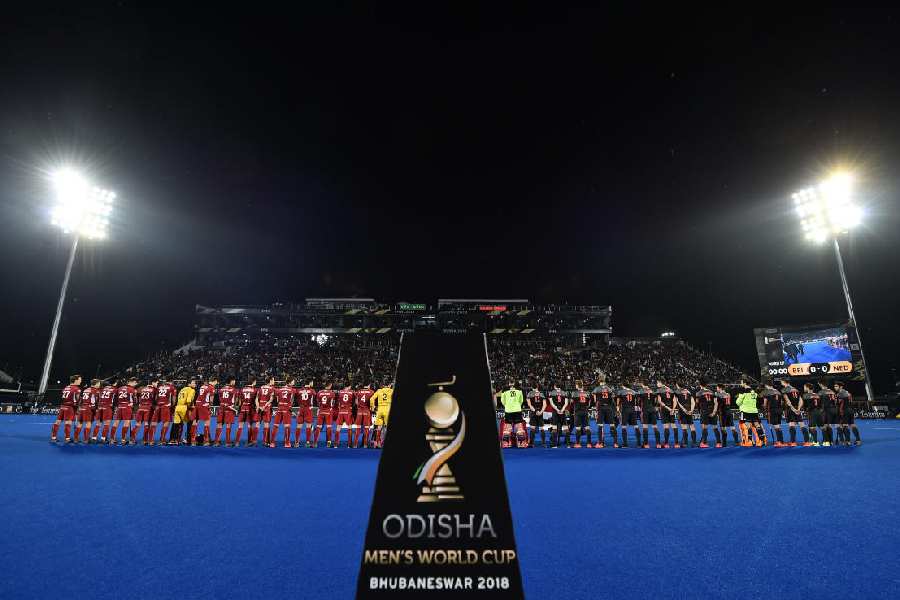Matches like these should have been hosted at the Salt Lake Stadium and not in Bhubaneswar,” said the football official from Bengal with some disappointment. He was talking about the 2026 World Cup Qualifier between India and Qatar held at Kalinga Stadium in Bhubaneswar in November last year.
It was full house at the 12,000-capacity stadium. The fans, who came with drums and the Indian flag, kept cheering the home team despite the final score reading 3-0 in favour of the Asian champions Qatar.
“A Salt Lake Stadium would have accommodated five times more than what we saw in Odisha but then to host matches like these, Bengal has to be more proactive. The Odisha government and its chief minister Naveen Patnaik have the vision, which is missing in our state,” said the same official.
It’s not the one-off qualifier that makes you notice the strides Odisha has taken in sports infrastructure.
Hours before the match on November 21, Arsene Wenger, legendary coach and Fifa’s chief of global football development, was at the Seventh Battalion ground. An MoU was signed between the All India Football Federation (AIFF) and the Odisha government for the AIFF Fifa Talent Academy. This academy could have come up anywhere, but only two parties had shown interest — the Odisha government and the Hyderabad-based Sreenidi Deccan FC. The AIFF thought it safe to enter into an understanding with a state government.
“If the government buys the idea then everything will be cleared in a matter of hours. No red-tapism, no intervention, nothing,” Abhijit Paul, joint secretary of the Football Association of Odisha and an AIFF executive committee member, told
The Telegraph.
“I shall give you one example. When the federation asked the member associations who would want to host the India vs Qatar match, Odisha won the race because the government readily accepted all terms and conditions. It’s not for nothing that the state is getting to host big-ticket sports events such as Hockey World Cups (2018 and 2023), Women’s U-17 World Cup (2022), Fifa World Cup Qualifiers or a top-notch tournament like Inter-Continental football,” added Paul.
He has a point. To host a World Cup Qualifier is such an expensive affair that even the Indian Football Association (IFA), the body that runs the game in Bengal, has to think twice. “Huge expense. Then there is logistics, security. It’s humongous,” said one IFA official.
To think of how a state once notorious for poverty, malnutrition and natural calamities is now being hailed as the new sports capital of the country. It’s beyond one’s imagination. The credit goes to chief minister Naveen Patnaik and his right-hand man V.K. Pandian.
Odisha became surplus in revenue from 2010-11 onwards and started focusing on rebuilding infrastructure in various fields including sports. From Rs 4 crore in 2001, the outlay for sports is now Rs 1,300 crore — one of the highest in the country.
Odisha was praised for successfully hosting the 2017 Asian Athletics Championship after Jharkhand backed out three months before the event. Then, in 2018, a cash-strapped Hockey India knocked on Odisha’s doors to bail it out on a short-term basis. A pragmatic Patnaik decided to sponsor the Indian hockey teams.
Hockey in India saw a revival after the support. The Kalinga Hockey Stadium also got a face-lift. In 2023, when Odisha was hosting the Hockey World Cup, Birsa Munda Hockey Stadium, the largest in the world, was inaugurated in Rourkela.
“Ahead of the 2018 Hockey World Cup, there was a search for a sponsor for the Indian hockey team. Naveenbabu came forward,” said Dilip Tirkey, who is former India hockey captain and current president of Hockey India. Tirkey is the first player from the Sundargarh region in Odisha to represent the senior team.
“Naveenbabu worked on three fronts — building infrastructure, organising world-class tournaments and creating confidence among players. Not only hockey but other sports also flourished,” he added.
Tirkey has not forgotten the dark days. He recalls, “Only a small sports hostel at Kalinga Stadium. No ade-quate infrastructure and only one hockey turf. Now the state has more than 30 hockey turfs.”
“Being a player himself during his early days, Sir (Patnaik) has an emotional connection with hockey. He thinks hockey gives us nationalistic pride since India has been playing this game from before Independence,” said Vineel Krishna,
commissioner-cum-secretary, sports and youth servi- ces, Odisha.
Corporates such as ArcelorMittal Nippon Steel India, the Tata Group and the Dalmia Bharat Group are collaborating with the Odisha government. Bhubaneswar will have an indoor athletics centre. It will be South Asia’s largest indoor athletic stadium featuring a 200-metre athletics track. Very soon, the country’s largest sports science centre at the Kalinga Stadium will be inaugurated.
To nurture rural talents, over 90 multipurpose indoor stadiums are being built across the state. The government is also building pucca houses for gifted athletes from underprivileged families. The huge cash incentives given to players for winning a medal at the international level have also given a boost to the promotion of sports, according to sprinter Dutee Chand.
Krishna said, “We know how to take care of athletes. They do not have to look for us, we find them and help them out.”
Sounds quite like a plan in motion.










